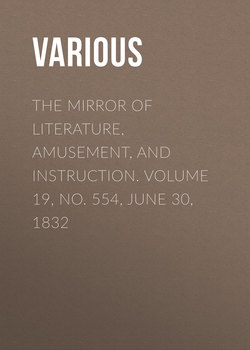The Mirror of Literature, Amusement, and Instruction. Volume 19, No. 554, June 30, 1832

Реклама. ООО «ЛитРес», ИНН: 7719571260.
Отрывок из книги
J.H.L.H. 4
Though the country people assigned many superstitious causes for this strange phenomenon, the naturalist could assign no physical one, that was in any degree satisfactory. Some thought it was owing to the twisting and friction of the roots: others thought that it proceeded from water, which had collected in the body of the tree; or, perhaps, from pent air: but the cause that was alleged appeared unequal to the effect. In the mean time, the tree did not always groan; sometimes disappointing its visitants; yet no cause could be assigned for its temporary cessations, either from seasons, or weather. If any difference was observed, it was thought to groan least when the weather was wet, and most when it was clear and frosty; but the sound at all times seemed to come from the roots.
.....
Hurley Place was originally a monastery. In the Domesday Book, it is said to have lately belonged to Edgar; but was then the property of Geoffrey de Mandeville, who received it from William the Conqueror, as a reward for his gallant conduct in the battle of Hastings; and in the year 1086 founded a monastery here for Benedictines, and annexed it as a cell to Westminster Abbey, where the original charter is still preserved.
On the dissolution of the monasteries, Hurley became the property of a family named Chamberlain, of whom it was purchased, in the reign of Queen Elizabeth, by Richard Lovelace, a soldier of fortune, who went on an expedition against the Spaniards with Sir Francis Drake, and erected the present mansion on the ruins of the ancient building, with the property he acquired in that enterprise. The remains of the monastery may be traced in the numerous apartments which occupy the west end of the house; and in a vault beneath the hall some bodies in monkish habits have been found buried. Part of the chapel, or refectory, also, may be seen in the stables, the windows of which are of chalk; and though made in the Conqueror's time, appear as fresh as if they were of modern workmanship. The Hall is extremely spacious, occupying nearly half the extent of the house. The grand saloon is decorated in a singular style, the panels being painted with upright landscapes, the leafings of which are executed with a kind of silver lacker. The views seem to be Italian, and are reputed to have been the work of Salvator Rosa, purposely executed to embellish this apartment. The receipt of the painter is said to be in the possession of Mr. Wilcox, the late resident.
.....